|
How to Use the "Maitski Line Reports" to
Get an Idea About Which Way Homes Prices Are Going
For years I have been putting out monthly price charts for single
family home prices in Atlanta.
This chart shows the number of sales per month (demand) vs. the
price
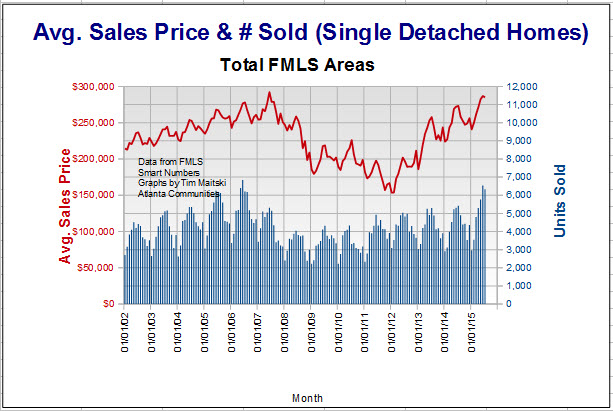
It's nice to see what has happened
but it does nothing to predict the future of prices.
Then I began tracking the
inventory of single family detached homes (supply).
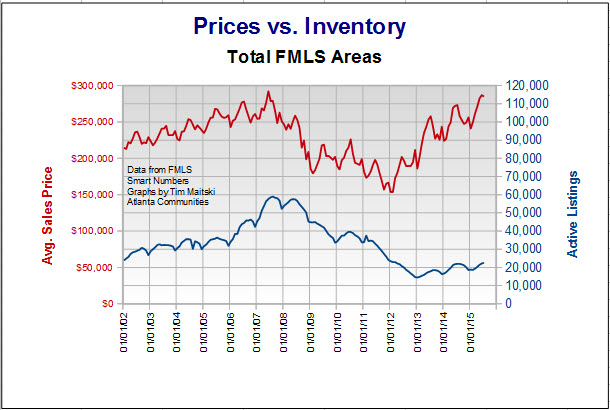
The key "aha moment" was when I took a look at the ratio of
inventory/sales. You can call it the supply/demand ratio
(Absorption rate). I divided the monthly inventory of homes by the monthly
number of sales and plotted it against the monthly sales prices.
I had never
seen a chart of absorption rates over any significant length of time plotted alongside
home prices.
Since we've had some of the most dramatic price
moves in Atlanta real estate over the past ten years, the thought
was that I might be
able to see how prices and absorption rate are correlated and
possibly see if it could be used as a leading indicator.
In the chart below, pay attention
the blue line (Inventory/Sales Ratio). When it stayed above
its historic range (between the two green lines), in 2007 prices soon fall.
When it fell below its historic range, in 2012 prices soon rose
dramatically.
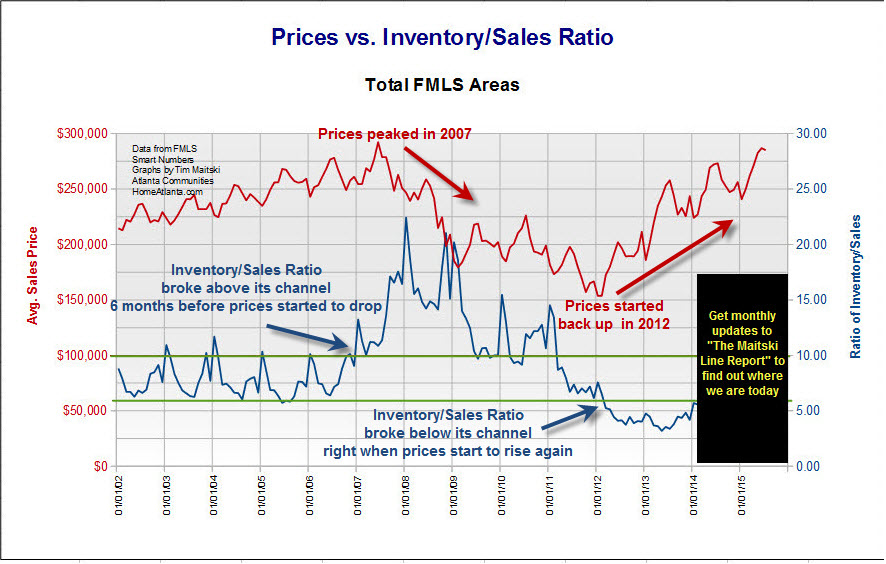
In the chart below, notice how the seasonal peaks and
valleys of the Inventory/Sales ratio (the blue line) corresponds with the seasonal
peaks and valleys of prices (the red line).
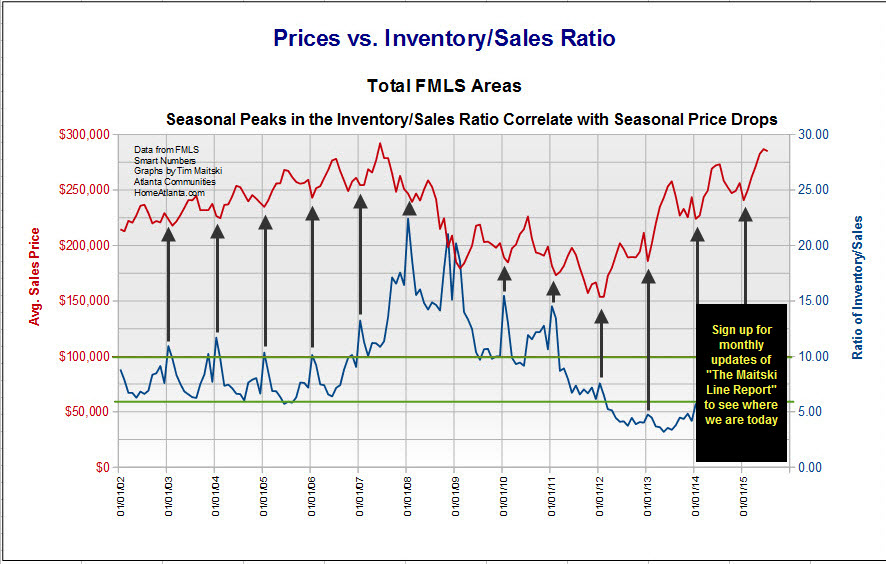
Every year in January, when the
inventory/sales ratio peaks (more supply than demand) prices seem to
be at their seasonal lows. When the tables turn in the summer
(low supply and high demand) prices are at their seasonal highs.
This is a picture of supply and demand in action. It validates the
correlation of this indicator to prices on a yearly
basis and therefore should correlate to the longer real estate
cycles. Taking advantage of these longer real estate cycles is
what we are really after. We all got a wake up call repeating
the mantra that real estate prices can only go up.
You can also see that the
inventory/sales ratio stayed in the fairly tight band, between 6 and
10, between 2002 to 2006. This was a time when prices in
Atlanta were rising steadily at about 4.5% per year.

Look at what happened when that ratio went above 10 and
kept going up in the spring of 2007. 6-12 months later prices
started to fall. There was too much supply and not enough
demand and therefore prices started to adjust. Real estate isn't liquid
like stocks and bonds. It takes months instead of seconds for
prices to adjust. Therefore you have some time to take
advantage of the information.
Prices kept falling until the
inventory/sales ratio fell to below 6 in the spring of 2012.
Since then, the inventory/sales ratio has been below six and prices
have risen by 52% from their lows. Supply is low while demand
is high and therefore the prices have adjusted higher.
To smooth out the seasonality
noise, I plotted a twelve month moving average. With the chart
below, follow the blue line, the 12 month moving average for the
inventory/sales ratio (absorption rate). A rise to above 10
preceded the start of the fall in prices in 2007. I
call this "The Maitski Sell Line". If you were thinking
of selling, that would have been a great time to get out near the top.
If you were thinking of buying, that would have been a great time to wait
it out and rent instead.
When the blue line fell below 6 in
2012, shortly thereafter
prices increased sharply. I call this "The Maitski Buy Line".
That was the time to buy if you were renting. If you owned a
home and wanted to sell, it might have been a time to wait, if possible,
knowing that prices would eventually go higher.
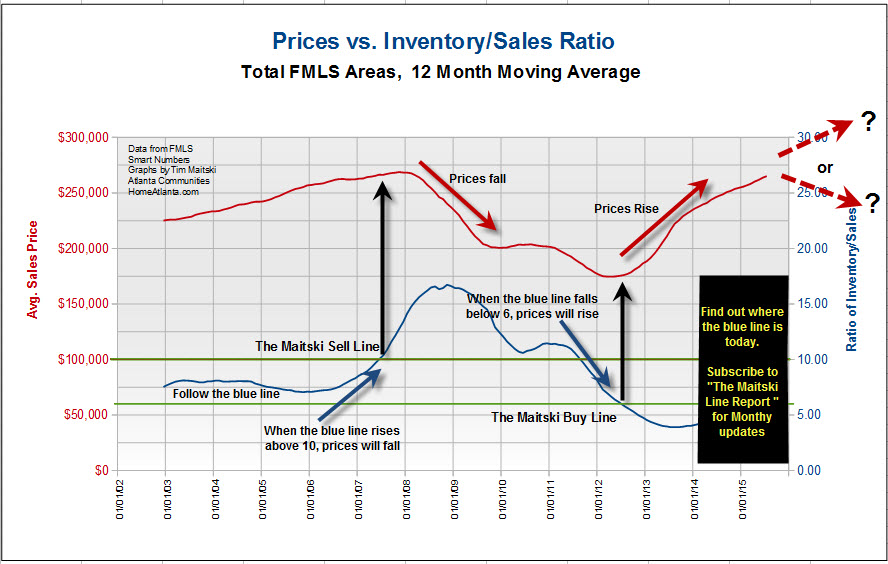
Of course, past performance is no guarantee of
future performance, but taken along with other statistics, such as
total days on the market, one can have an objective indicator on
which to base a buy/sell decision on. History never repeats
itself exactly but it's worthwhile to study past patterns and apply
them to today's market.
My theory is based on simple economics. When the
supply/demand ratio is outside of its historic channel, prices will
change until that ratio gets back to normal levels.
If the ratio is high, prices will fall.
If the ratio is low, prices will rise.
To find out where the blue line is today, sign
up for the monthly updates in the box below. I not only have
the charts I created for the overall Atlanta area, I have detailed
charts for 37 more localized areas around Atlanta.
Keep Your Transaction Costs to a
Minimum
If you buy a home with me and then
want to sell within one year due to a "Maitski Sell Signal", I will
sell your home for a total of 4.5% commission instead of my
customary 6% commission
Use Us as Your Buyer's Agent
Collect a Rebate for 50% of Our Commission
It's Our "Referral Fee" to You for
Finding Us on the Internet
No Upfront Fees, No Cost to You
Whatsoever |









